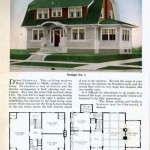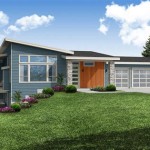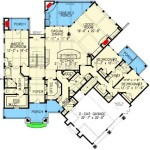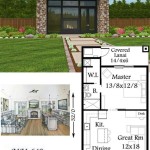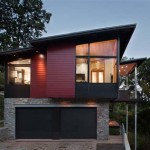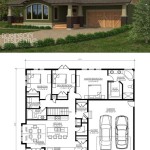Mexican Style House Plans refer to architectural designs that draw inspiration from the traditional building practices and aesthetics of Mexico. These plans often incorporate elements such as vibrant colors, arches, tile roofs, and intricate ironwork, creating a distinctive aesthetic that evokes the rich cultural heritage of the region. From luxurious haciendas to cozy casitas, Mexican style homes embody a fusion of Spanish colonial and indigenous influences, making them highly sought after by those seeking a unique and charming living space.
The popularity of Mexican style house plans is not limited to Mexico itself. In various parts of the world, architects and homeowners have embraced this architectural style, incorporating its signature elements into modern and contemporary designs. The fusion of traditional Mexican aesthetics with modern amenities has resulted in stunning homes that cater to the preferences of discerning homeowners who value cultural authenticity and aesthetic appeal.
Now let’s delve into the key characteristics and design principles that define Mexican style house plans, exploring the architectural elements and cultural influences that make them so alluring.
Mexican style house plans are renowned for their distinctive characteristics that blend traditional Mexican aesthetics with modern functionality. Here are 8 important points that define this captivating architectural style:
- Vibrant Colors
- Arches and Curves
- Tile Roofs
- Intricate Ironwork
- Open Floor Plans
- Courtyards and Patios
- Natural Materials
- Cultural Influences
These elements come together to create homes that are both visually stunning and highly livable, offering a unique blend of comfort and cultural charm.
Vibrant Colors
Mexican style house plans are renowned for their use of vibrant colors, which create a warm and inviting atmosphere while reflecting the rich cultural heritage of the region. These colors are often inspired by the natural surroundings, such as the turquoise waters of the Caribbean Sea, the golden hues of the desert, and the lush greenery of the rainforest.
- Bold and Saturated Hues: Mexican style homes embrace bold and saturated colors, such as deep reds, oranges, yellows, and blues. These colors add a sense of energy and vibrancy to the home, creating a cheerful and welcoming environment.
- Earthy and Natural Tones: In addition to bold hues, Mexican style house plans also incorporate earthy and natural tones, such as beige, terracotta, and brown. These colors evoke a sense of warmth and connection to the natural world, creating a serene and inviting atmosphere.
- Colorful Accents: Mexican style homes often feature colorful accents, such as brightly painted doors, window frames, and tiles. These accents add a touch of whimsy and personality to the home, reflecting the vibrant and celebratory nature of Mexican culture.
- Cultural Significance: The use of vibrant colors in Mexican style house plans goes beyond aesthetics. Many colors hold cultural significance and symbolism, representing different aspects of Mexican heritage and traditions.
The incorporation of vibrant colors in Mexican style house plans creates a visually stunning and welcoming environment that celebrates the rich cultural heritage of Mexico.
Arches and Curves
Arches and curves are defining features of Mexican style house plans, adding a touch of elegance and visual interest while reflecting the architectural influences of the region.
Rounded Doorways and Windows: Mexican style homes often feature rounded doorways and windows, creating a welcoming and inviting atmosphere. The soft curves add a sense of warmth and character, while also providing a nod to the Spanish colonial heritage.
Arched Entryways: Grand arched entryways are a common sight in Mexican style homes, particularly in haciendas and other traditional dwellings. These arches create a sense of grandeur and formality, while also providing a dramatic focal point for the home.
Curved Roofs and Balconies: In some Mexican style house plans, roofs and balconies are adorned with curves, adding a touch of whimsy and visual interest. These curves can be subtle or pronounced, depending on the desired effect.
Cultural Influences: The use of arches and curves in Mexican style house plans draws inspiration from various cultural influences. The rounded shapes are reminiscent of Moorish architecture, while the grand arches reflect the influence of Spanish colonial design.
Overall, arches and curves play a significant role in defining the aesthetic appeal of Mexican style house plans, creating a harmonious blend of elegance, warmth, and cultural charm.
Tile Roofs
Tile roofs are a distinctive and essential element of Mexican style house plans, adding a touch of rustic charm and architectural interest while providing practical benefits.
Clay or Ceramic Tiles: Mexican style tile roofs are typically made of clay or ceramic tiles, which are durable, weather-resistant, and available in a wide range of colors and finishes. The tiles are often hand-crafted, giving each roof a unique and artisanal character.
Barrel or Flat Shapes: The tiles are typically shaped into barrels or flats, with the barrel tiles being more common in traditional Mexican architecture. The tiles are laid in overlapping rows, creating a waterproof and visually appealing roof.
Colorful Glazes: Mexican style tile roofs often feature colorful glazes, adding a vibrant touch to the home. The glazes can be glossy or matte, and come in a wide range of hues, from deep reds and oranges to bright blues and greens.
Practical Benefits: In addition to their aesthetic appeal, tile roofs offer several practical benefits. They are highly durable and can withstand extreme weather conditions, including heavy rains, strong winds, and intense sunlight. Tile roofs also provide excellent insulation, helping to regulate the temperature inside the home.
Overall, tile roofs are an integral part of Mexican style house plans, combining aesthetic charm, durability, and practical benefits to create a unique and inviting living space.
Intricate Ironwork
Intricate ironwork is a defining characteristic of Mexican style house plans, adding a touch of elegance, security, and cultural charm to the home.
Wrought Iron Elements: Mexican style homes often feature wrought iron elements, such as gates, fences, balconies, and window grills. These elements are hand-crafted by skilled artisans, who use traditional techniques to create intricate designs and patterns.
Floral and Geometric Motifs: The ironwork in Mexican style house plans often incorporates floral and geometric motifs, which add a touch of elegance and visual interest to the home. The motifs may be simple or elaborate, depending on the desired effect.
Security and Privacy: In addition to their aesthetic appeal, wrought iron elements also provide security and privacy to the home. Iron gates and fences can help to deter intruders, while window grills can provide protection from unwanted visitors.
Cultural Significance: The use of intricate ironwork in Mexican style house plans has cultural significance, as it reflects the influence of Spanish colonial architecture. Ironwork was a common feature in Spanish colonial buildings, and it has been incorporated into Mexican architecture over the centuries.
Overall, intricate ironwork is an essential element of Mexican style house plans, adding a touch of elegance, security, and cultural charm to the home.
Open Floor Plans
Open floor plans, characterized by large, interconnected spaces that seamlessly flow into one another, are a defining feature of Mexican style house plans.
- Spacious and Inviting: Open floor plans create a sense of spaciousness and invite natural light to flow throughout the home. This layout promotes a feeling of openness and encourages interaction between family members and guests.
- Functional and Flexible: Open floor plans offer flexibility in terms of furniture arrangement and room usage. The large, open spaces can be easily adapted to accommodate different activities and lifestyles.
- Improved Communication and Connectivity: Open floor plans facilitate better communication and connectivity among family members. The absence of walls and barriers allows for clear sightlines and easy conversation between different areas of the home.
- Enhanced Natural Light: The open and interconnected nature of Mexican style house plans allows for ample natural light to penetrate the home. This not only creates a brighter and more inviting atmosphere but also reduces the need for artificial lighting.
Overall, open floor plans are an essential element of Mexican style house plans, contributing to the home’s spaciousness, functionality, and overall livability.
Courtyards and Patios
Courtyards and patios are essential elements of Mexican style house plans, creating outdoor living spaces that seamlessly blend with the interior of the home.
Private Oasis: Courtyards and patios offer a private oasis within the home, providing a tranquil retreat from the hustle and bustle of daily life. They are often surrounded by walls or lush greenery, creating a sense of seclusion and privacy.
Outdoor Living and Entertaining: Courtyards and patios extend the living space outdoors, providing areas for relaxation, dining, and entertainment. They can be furnished with comfortable seating, outdoor kitchens, and fire pits, creating inviting spaces for family gatherings and social events.
Connection to Nature: Courtyards and patios bring the outdoors in, creating a connection between the home and its natural surroundings. They often feature lush gardens, water features, and natural elements, such as stone and wood, which enhance the sense of tranquility and well-being.
Overall, courtyards and patios are integral to Mexican style house plans, offering private outdoor living spaces that seamlessly blend with the interior of the home, providing a sanctuary for relaxation, entertainment, and connection with nature.
Natural Materials
Mexican style house plans prioritize the use of natural materials, which create a sense of authenticity, warmth, and connection to the environment.
- Adobe and Stone: Adobe, a mixture of earth, clay, and straw, and stone are traditional building materials used in Mexican architecture. These materials provide excellent thermal insulation, keeping homes cool in the summer and warm in the winter. They also contribute to the home’s overall structural stability and durability.
- Wood: Wood is another common natural material used in Mexican style house plans. It is often used for structural elements, such as beams and columns, as well as for decorative elements, such as doors, windows, and furniture. Wood adds warmth and character to the home, creating a sense of rustic charm.
- Tile and Ceramics: Mexican style house plans often incorporate colorful tiles and ceramics, which add a touch of vibrancy and cultural flair to the home. Tiles are used for flooring, countertops, and backsplashes, while ceramics are used for decorative accents, such as pottery and sculptures.
- Natural Fabrics: Natural fabrics, such as cotton, linen, and wool, are commonly used in Mexican style house plans. These fabrics are breathable and comfortable, adding to the home’s overall sense of warmth and coziness. They are often used for curtains, bedding, and upholstery.
The use of natural materials in Mexican style house plans creates a harmonious connection between the home and its surroundings, while also providing practical benefits such as durability, thermal insulation, and a sense of cultural authenticity.
Cultural Influences
Mexican style house plans draw inspiration from various cultural influences, reflecting the rich heritage and traditions of Mexico.
- Spanish Colonial Architecture: Mexican style house plans exhibit a strong influence from Spanish colonial architecture, which was introduced during the Spanish colonization of Mexico in the 16th century. Elements such as arches, courtyards, and tile roofs are reminiscent of Spanish colonial buildings, adding a touch of grandeur and historical charm to Mexican style homes.
- Indigenous Influences: Mexican style house plans also incorporate elements from indigenous cultures, particularly those of the Aztec and Mayan civilizations. The use of natural materials, such as adobe and stone, and the incorporation of traditional motifs and patterns reflect the deep connection between Mexican culture and its indigenous roots.
- Moorish Influences: Mexican style house plans sometimes incorporate elements of Moorish architecture, which was brought to Spain by the Moors during their occupation of the Iberian Peninsula. Features such as intricate ironwork, colorful tiles, and geometric patterns add a touch of exotic flair and cultural diversity to Mexican style homes.
- Contemporary Influences: While Mexican style house plans are rooted in tradition, they also incorporate contemporary influences, reflecting the evolving tastes and lifestyles of modern homeowners. The use of modern materials, such as glass and steel, and the incorporation of sustainable design principles ensure that Mexican style homes remain relevant and appealing in the 21st century.
The of these diverse cultural influences creates a unique and eclectic style that is both authentically Mexican and universally appealing, making Mexican style house plans a popular choice for homeowners seeking a rich and culturally diverse living environment.










Related Posts

